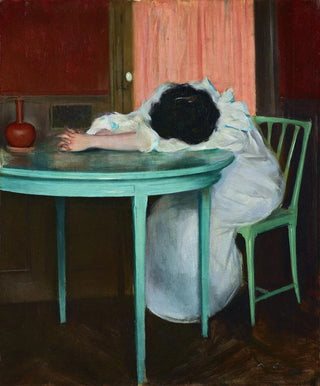Art print | Tired - Ramon Casas


View from behind

Frame (optional)
The artwork "Fatigué" by Ramon Casas is set in a period when Catalan art is experiencing an unprecedented effervescence. This painting, emblematic of Spanish modernism, captures with rare finesse the state of mind of a man overwhelmed by weariness. The composition, both simple and evocative, engages the viewer, inviting them to share an intimate moment with the subject. The soft light bathing the scene, along with the delicate nuances of the colors, helps create a nostalgic and contemplative atmosphere. This artwork does not merely depict a tired individual; it evokes a universe where every detail tells a story, where each gaze reflects on the human condition.
Style and uniqueness of the artwork
Ramon Casas's style is distinguished by its realistic approach, combined with a modernist sensibility. In "Fatigué," the representation of the character aims to be both faithful and expressive, capturing not only physical features but also a certain melancholy emanating from his being. The brushstrokes, both delicate and assertive, give a lively texture to the canvas. Shadows play a crucial role, adding depth and dimension to the scene. Casas, a virtuoso, manages to infuse a palpable life into his subject, transforming a moment of fatigue into a vibrant art piece. This ability to transcend everyday life through art is one of the artist's hallmarks, making his creations reflections on human nature.
The artist and his influence
Ramon Casas, a major figure of Catalan modernism, knew how to leave his mark on his era with an innovative artistic vision. Born in Barcelona, he was influenced by European artistic currents while incorporating elements of Spanish culture. His work, often focused on daily life and portraits, paved the way for many contemporary artists. Casas was able to capture the essence of his time, blending realism with a touch of impressionism. His influence is felt not only within the artistic circles of his time but also among subsequent generations who saw in him a pioneer. "Fatigué" bears witness to this approach, combining mastered technique with sincere emotion, and

Matte finish

View from behind

Frame (optional)
The artwork "Fatigué" by Ramon Casas is set in a period when Catalan art is experiencing an unprecedented effervescence. This painting, emblematic of Spanish modernism, captures with rare finesse the state of mind of a man overwhelmed by weariness. The composition, both simple and evocative, engages the viewer, inviting them to share an intimate moment with the subject. The soft light bathing the scene, along with the delicate nuances of the colors, helps create a nostalgic and contemplative atmosphere. This artwork does not merely depict a tired individual; it evokes a universe where every detail tells a story, where each gaze reflects on the human condition.
Style and uniqueness of the artwork
Ramon Casas's style is distinguished by its realistic approach, combined with a modernist sensibility. In "Fatigué," the representation of the character aims to be both faithful and expressive, capturing not only physical features but also a certain melancholy emanating from his being. The brushstrokes, both delicate and assertive, give a lively texture to the canvas. Shadows play a crucial role, adding depth and dimension to the scene. Casas, a virtuoso, manages to infuse a palpable life into his subject, transforming a moment of fatigue into a vibrant art piece. This ability to transcend everyday life through art is one of the artist's hallmarks, making his creations reflections on human nature.
The artist and his influence
Ramon Casas, a major figure of Catalan modernism, knew how to leave his mark on his era with an innovative artistic vision. Born in Barcelona, he was influenced by European artistic currents while incorporating elements of Spanish culture. His work, often focused on daily life and portraits, paved the way for many contemporary artists. Casas was able to capture the essence of his time, blending realism with a touch of impressionism. His influence is felt not only within the artistic circles of his time but also among subsequent generations who saw in him a pioneer. "Fatigué" bears witness to this approach, combining mastered technique with sincere emotion, and






